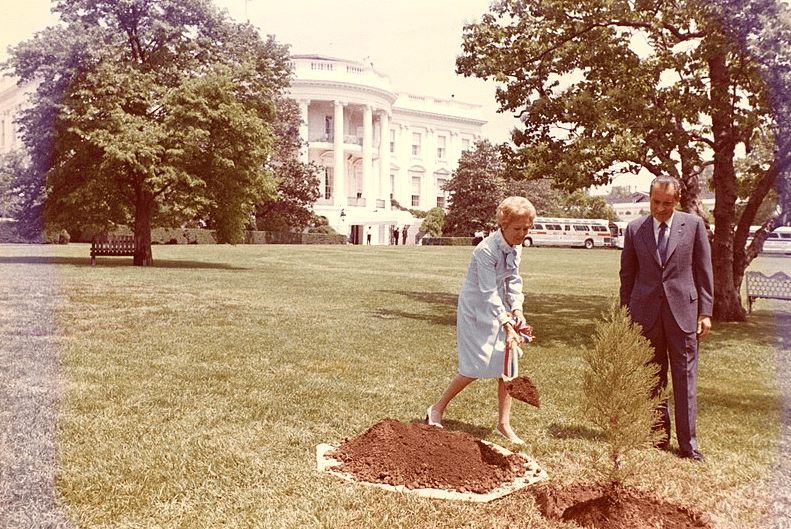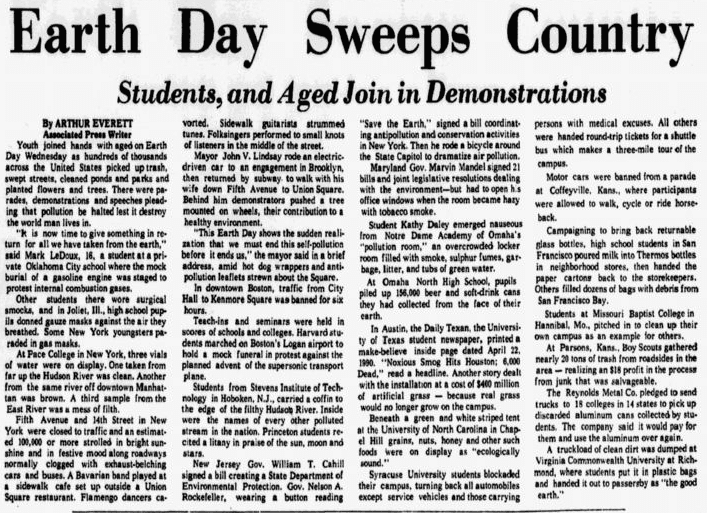Today is Earth Day, a global celebration of the Earth’s intricacy, beauty and fertility, and a call for greater environmental awareness and protection. First held in 1970, this special environmental event was instantly a rousing success, and has gained momentum and adherents ever since, beginning a “green” movement across the world. Along with Earth Day, there is now an Earth Week, and a U.N.-sponsored World Environment Day.

Earth Day was the brainchild of Gaylord Nelson, a U.S. senator from Wisconsin and an environmentalist. He envisioned teach-ins on campuses to raise environmental awareness, and demonstrations to express the public’s love and concern for the environment. He and California Representative Paul McCloskey publicized the upcoming event in a series of speeches, and the response was enthusiastic and uplifting. Teach-ins, parades and demonstrations were staged on hundreds of campuses and in many communities, and as many as 20 million Americans turned out to celebrate, protest, and learn.
Earth Day is a grassroots environmental movement at its best, with an incredible variety of activities and participants. This deep, personal involvement at the student and community level was demonstrated at the very first Earth Day celebration, as reported on the front page of this Texas newspaper.

Here is a transcription of this article:
Earth Day Sweeps Country
Students, and Aged Join in Demonstrations
By Arthur Everett
Associated Press Writer
Youth joined hands with aged on Earth Day Wednesday as hundreds of thousands across the United States picked up trash, swept streets, cleaned ponds and parks, and planted flowers and trees. There were parades, demonstrations and speeches pleading that pollution be halted lest it destroy the world man lives in.
“It is now time to give something in return for all we have taken from the earth,” said Mark LeDoux, 16, a student at a private Oklahoma City school where the mock burial of a gasoline engine was staged to protest internal combustion gases.
Other students there wore surgical smocks, and in Joliet, Ill., high school pupils donned gauze masks against the air they breathed. Some New York youngsters paraded in gas masks.
At Pace College in New York, three vials of water were on display. One taken from far up the Hudson River was clean. Another from the same river off downtown Manhattan was brown. A third sample from the East River was a mess of filth.
Fifth Avenue and 14th Street in New York were closed to traffic and an estimated 100,000 or more strolled in bright sunshine and in festive mood along roadways normally clogged with exhaust-belching cars and buses. A Bavarian band played at a sidewalk café set up outside a Union Square restaurant. Flamengo dancers cavorted. Sidewalk guitarists strummed tunes. Folksingers performed to small knots of listeners in the middle of the street.
Mayor John V. Lindsay rode an electric-driven car to an engagement in Brooklyn, then returned by subway to walk with his wife down Fifth Avenue to Union Square. Behind him demonstrators pushed a tree mounted on wheels, their contribution to a healthy environment.
“This Earth Day shows the sudden realization that we must end this self-pollution before it ends us,” the mayor said in a brief address, amid hot dog wrappers and anti-pollution leaflets strewn about the Square.
In downtown Boston, traffic from City Hall to Kenmore Square was banned for six hours.
Teach-ins and seminars were held in scores of schools and colleges. Harvard students marched on Boston’s Logan airport to hold a mock funeral in protest against the planned advent of the supersonic transport plane.
Students from Stevens Institute of Technology in Hoboken, N.J., carried a coffin to the edge of the filthy Hudson River. Inside were the names of every other polluted stream in the nation. Princeton students recited a litany in praise of the sun, moon and stars.
New Jersey Gov. William T. Cahill signed a bill creating a State Department of Environmental Protection. Gov. Nelson A. Rockefeller, wearing a button reading “Save the Earth,” signed a bill coordinating antipollution and conservation activities in New York. Then he rode a bicycle around the State Capitol to dramatize air pollution.
Maryland Gov. Marvin Mandel signed 21 bills and joint legislative resolutions dealing with the environment – but had to open his office windows when the room became hazy with tobacco smoke.
Student Kathy Daley emerged nauseous from Notre Dame Academy of Omaha’s “pollution room,” an overcrowded locker room filled with smoke, sulphur fumes, garbage, litter, and tubs of green water.
At Omaha North High School, pupils piled up 156,000 beer and soft-drink cans they had collected from the face of their earth.
In Austin, the Daily Texan, the University of Texas student newspaper, printed a make-believe inside page dated April 22, 1990. “Noxious Smog Hits Houston; 6,000 Dead” read a headline. Another story dealt with the installation at a cost of $400 million of artificial grass – because real grass would no longer grow on the campus.
Beneath a green and white striped tent at the University of North Carolina in Chapel Hill grains, nuts, honey and other such foods were on display as “ecologically sound.”
Syracuse University students blockaded their campus, turning back all automobiles except service vehicles and those carrying persons with medical excuses. All others were handed roundtrip tickets for a shuttle bus which makes a three-mile tour of the campus.
Motor cars were banned from a parade at Coffeyville, Kans., where participants were allowed to walk, cycle or ride horseback.
Campaigning to bring back returnable glass bottles, high school students in San Francisco poured milk into Thermos bottles in neighborhood stores, then handed the paper cartons back to the storekeepers. Others filled dozens of bags with debris from San Francisco Bay.
Students at Missouri Baptist College in Hannibal, Mo., pitched in to clean up their own campus as an example for others.
At Parsons, Kans., Boy Scouts gathered nearly 20 tons of trash from roadsides in the area – realizing an $18 profit in the process from junk that was salvageable.
The Reynolds Metal Co. pledged to send trucks to 18 colleges in 14 states to pick up discarded aluminum cans collected by students. The company said it would pay for them and use the aluminum over again.
A truckload of clean dirt was dumped at Virginia Commonwealth University at Richmond, where students put it in plastic bags and handed it out to passersby as “the good earth.”
Note: An online collection of newspapers, such as GenealogyBank’s Historical Newspaper Archives, is not only a great way to learn about the lives of your ancestors – the old newspaper articles also help you understand American history and the times your ancestors lived in, and the news they talked about and read in their local papers – as well as more recent events. Have you been involved in the green movement? Have you personally headed up initiatives to save the planet? Please share your stories with us in the comments section below.
Explore over 330 years of newspapers and historical records in GenealogyBank. Discover your family story! Start a 7-Day Free Trial
